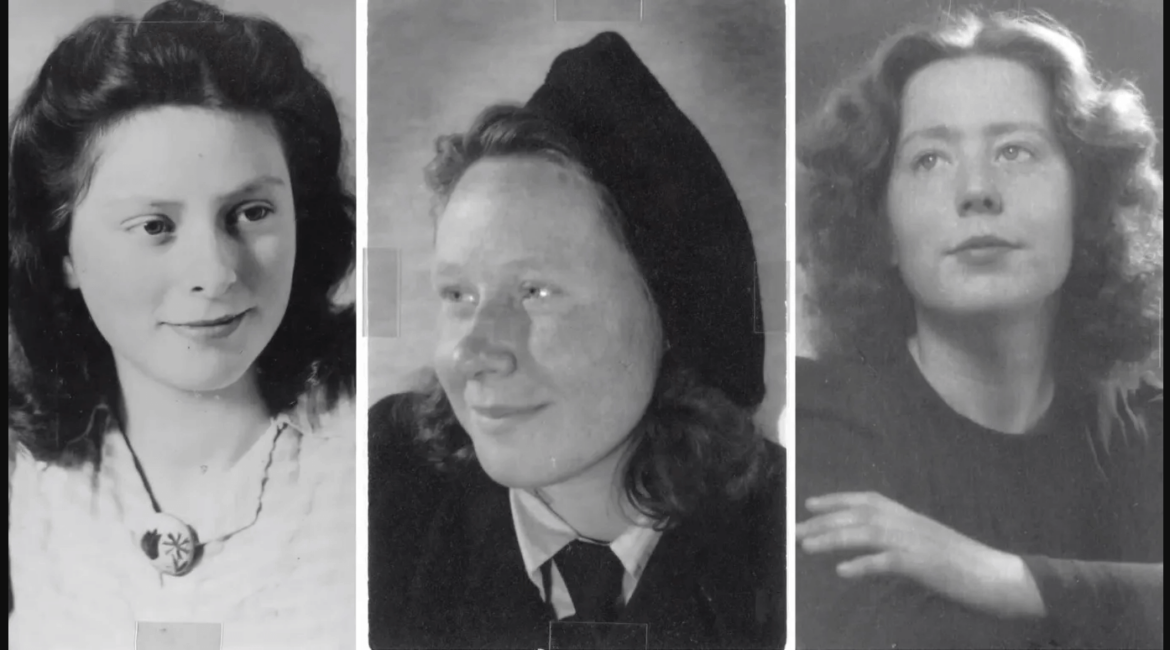While sorting through old books someone handed me to discard, I unexpectedly discovered a rich collection of World War II tales, offering an intimate look into that historical era. It was a poignant reminder of the hidden stories that often lie in overlooked places. Here’s one of the gems.
During the dark days of World War II, when the Nazi regime was spreading terror across Europe, the Netherlands witnessed the rise of three courageous young women: Jannetje Johanna “Hannie” Schaft, Truus Oversteegen, and Freddie Oversteegen. These brave souls, barely out of their teenage years, took on a mantle of resistance that would make them icons of bravery and resilience.
Hannie Schaft and the Oversteegen sisters led regular lives before the war.
The Oversteegen family, with sisters Truus and Freddie, had faced domestic challenges. Their mother, Trijn, had separated from their father, though the parting was amicable. The young girls lived on a large ship in Haarlem and had limited contact with their father post-separation. Their home would soon become a sanctuary when, during the Nazi occupation, they secretly sheltered a Jewish couple.
The Nazi invasion deeply affected the inhabitants of the Netherlands. The young Oversteegen sisters, alongside their mother, began distributing anti-Nazi literature and other communist content, risking their lives in defiance of the occupying forces. This act of valor soon caught the attention of resistance groups. In 1941, Frans van der Wiel approached the family. Freddie recalled the moment vividly: a man at their doorstep, discussing the prospect of joining the resistance. Their mother’s only condition was that they retain their humanity in all tasks.
Initially, the girls were unaware of the full extent of their involvement. Their imaginations painted a picture of a covert army. Early on, their tasks included message delivery and identity paper smuggling, benefitting from the general underestimation and inattention of the Nazis due to their age and gender. They played crucial roles in helping Jewish individuals, especially children, evade capture. Freddie’s youthful appearance made her particularly adept at reconnaissance.
As the war progressed, their roles intensified. The girls were involved in more direct acts of sabotage against Nazi operations. They utilized their age and charm, distracting guards to enable fellow resistance fighters to execute their missions. One particularly daring tactic involved the young girls flirting with guards to divert their attention while other members set fire to enemy facilities.
By 1943, the duo became a trio with the inclusion of Hannie Schaft. She rapidly became a prominent figure in Dutch resistance. Such was her impact that she drew the attention of Hitler, becoming a significant target. Hannie Schaft symbolizes the fierce spirit of resistance that thrived in young hearts during WWII.
These three young women, through their acts of valor, have solidified their place in history, reminding us that age is no barrier to courage and resilience. Their story is a testament to the power of youth, determination, and the enduring spirit of resistance.
The Fate of Hannie Schaft
Hannie Schaft, often referred to as “the girl with the red hair”, stood as a beacon of hope and resistance during World War II in the Netherlands. Her fierce determination to fight against the Nazi regime earned her a spot on their most-wanted list. However, this bravery came at a steep cost. Just three weeks before the war’s conclusion, Schaft was executed by Dutch Nazi officials on 17 April 1945. Although there was an understanding to halt executions between the occupier and the Binnenlandse Strijdkrachten (Dutch resistance), Hannie’s life was tragically cut short in the dunes of Overveen, near Bloemendaal.
Freddie Oversteegen
As one of the fearless teenage sisters who joined the Dutch resistance, Freddie Oversteegen showcased immense courage and resilience. While her war efforts alongside her sister Truus and comrade Hannie Schaft are widely recognized, Freddie’s life post-war remained profound. She lived a long life, passing away at the age of 92 in 2018 in Driehuis, Netherlands. Freddie’s journey offers an introspective look into the life of a war hero after the battles are over, reflecting on the scars, memories, and legacy left behind.
Hannie Schaft’s compelling story of courage and defiance against the Nazis has inspired filmmakers. The 1981 Dutch drama film, “The Girl with the Red Hair” (Dutch: Het meisje met het rode haar), directed by Ben Verbong, pays homage to this legendary resistance fighter. Based on Hannie’s biography, the movie captures the essence of her spirit, her contributions to the resistance, and the indomitable will of a young woman against the backdrop of a world at war. The cinematic portrayal serves as a testament to her enduring legacy and the sacrifices made for freedom.
Some interesting takeaways from the story.
- Despite their immense contributions to the resistance, the Oversteegen sisters began their activities at shockingly young ages, with Freddie being only 14 when she first started.
- Freddie once narrowly escaped capture when a pair of German soldiers approached her while she was on a mission. Her quick thinking, pretending to be just an innocent young girl out for a stroll, saved her.
- To communicate covertly, the girls often used secret codes and signals, including seemingly innocent actions like tying shoelaces in specific patterns.
- Their youthful appearance was a perfect disguise. The Nazis rarely suspected young girls to be involved in underground activities, making the girls’ actions even more daring and risky.
- The Oversteegen sisters’ mother played a vital role in shaping their moral compass. She advised them to always remain human, no matter what the resistance asked of them.
- After the war, Truus Oversteegen got a tattoo of a butterfly on her ankle, symbolizing freedom and transformation, a constant reminder of the war years.
- Despite their significant contributions, the Oversteegen sisters and Hannie Schaft weren’t immediately recognized after the war for their heroics due to political tensions between communists and other groups in post-war Netherlands.
- The girls underwent rigorous training. Besides learning to shoot, they were taught sabotage techniques, how to surveil targets, and even how to act natural when being watched.
- After the war, Truus dedicated her life to preserving the memory of Hannie Schaft, ensuring that her sacrifice and contributions would never be forgotten.
- The young girls, on a few occasions, used poems as a means to convey messages and spread anti-Nazi sentiments, proving that even in war, art and expression found its way.
While history books often glorify prominent leaders and grand events, the tales of Hannie, Truus, and Freddie remind you of the significant impact that everyday heroes can make. It’s a nudge for you and those around you to appreciate the unsung heroes in your lives and communities. By recognizing and celebrating their contributions, you ensure that their legacies live on, inspiring future generations to act with courage and conviction.
- Transform Your Health with Medford Medical Weight Loss Program - June 9, 2025
- A Chat with Nate and Mika, Christian Wedding Photographers - July 18, 2024
- Ultimate Guide To Playing Online Casinos - May 27, 2024







